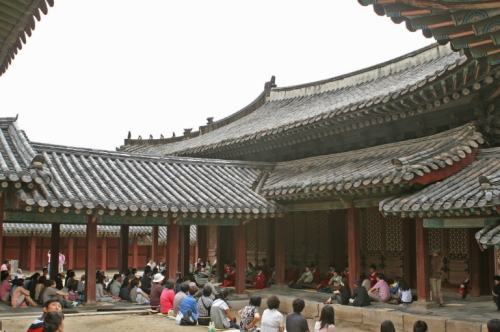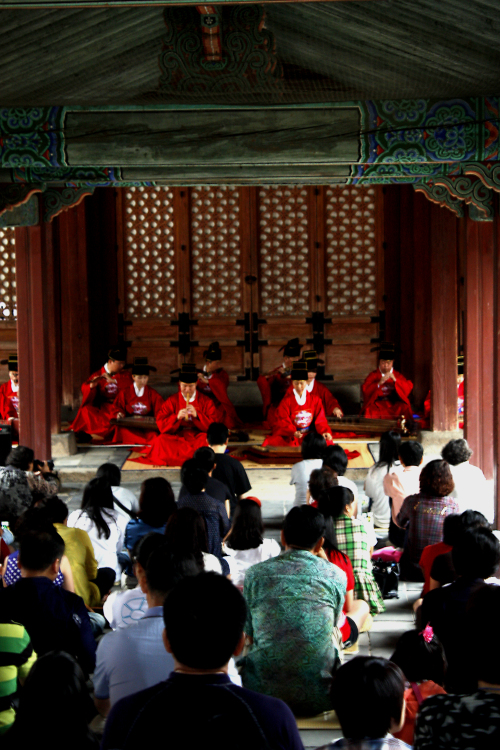‘Day Break at Changgyeong Palace’ presents unique cultural experience
It is 7 a.m. on a Saturday morning, and Changgyeonggung, one of the five grand palaces of the Joseon Dynasty, is enveloped in haze and dewy air.
In spite of the early hour, the gallery behind Myeongjeongjeon hall of the palace is completely packed with people. Some skipped breakfast, and some left their homes in the countryside at 4 a.m. just to be here.
A one-of-a-kind traditional music experience is about to reward those who managed to wake up early. Organized by National Gugak Center, the concert, named “Day Break at Changgyeong Palace” is bringing traditional court music of the Joseon Dynasty (1932-1987) back to the very place the piece was performed and enjoyed in the old days.
It is 7 a.m. on a Saturday morning, and Changgyeonggung, one of the five grand palaces of the Joseon Dynasty, is enveloped in haze and dewy air.
In spite of the early hour, the gallery behind Myeongjeongjeon hall of the palace is completely packed with people. Some skipped breakfast, and some left their homes in the countryside at 4 a.m. just to be here.
A one-of-a-kind traditional music experience is about to reward those who managed to wake up early. Organized by National Gugak Center, the concert, named “Day Break at Changgyeong Palace” is bringing traditional court music of the Joseon Dynasty (1932-1987) back to the very place the piece was performed and enjoyed in the old days.

Before the concert begins, professor Song Hye-jin, who teaches traditional Korean music at Sookmyung Women’s University, appears on stage.
“Congratulations on being here,’ she says. “You are only going to hear one piece of music today. And you might be surprised. It is over 50 minutes long.”
The piece, “Yeongsanhoesang,” is believed to have been written as a Buddhist piece during Korea’s Goryeo period (918-1392), or even before, according to Song. “The term ‘Yeongsan’ in the title refers to the mountain in India where Buddha used to stay and hold meetings with his followers,” Song tells The Korea Herald.
“The music depicted the spiritual interactions between Buddha and those who followed him at the special mountain.”
“Yeongsanhoesang” was initially written as a vocal piece with spiritual lyrics, but instrumental variations were developed by Joseon musicians.
“Unlike Goryeo, Joseon embraced Confucianism while rejecting Buddhism,” Song says. “They wanted to keep playing the piece, as it was a superb one, but wanted to get rid of its religious qualities. So they removed the lyrics and created many sets of variations. One of them is chamber ensemble for court music. And many different traditional instruments, both string and wind, can be played either alone or as a duet for this piece.”

As members of Court Music Orchestra of National Gugak Center appear, the crowd becomes quiet. It’s almost magical ― even little children don’t make a sound. There’s something about the morning air in the palace, which is calm and strangely comforting.
Dressed in red hanbok, Korea’s traditional costume, the members of the orchestra begin to play. The beginning is rather slow and deep, with the resonating sound of the geomungo, a six stringed zither.
The chamber ensemble follows the geomungo solo. The ensemble, which consists of gayageum (a 12 stringed zither), daegeum (a large bamboo flute), piri, haegeum (two stringed fiddle), danso (short bamboo flute), yanggeum (western-style zither), and janggu (hourglass-shaped drum), create a simple yet touching musical harmony that compliments this beautiful historical site.
Many are closing their eyes, as if meditating. Some are looking at the roof of the palace instead of the orchestra. But no one makes a sound. It’s just the music that fills the space.
The rhythm gets faster and faster toward the end, yet it is not overwhelming. The music manages to keep its balance, and its sound gently touches one’s emotions. When the final note is played, it is hard to believe 50 minutes have already gone by. It feels incredibly short. The whole experience is almost therapeutic.
“This music really harmonizes and empathizes with the listeners’ emotions,” professor Song explains. “It becomes a part of you and you become a part of the music. It draws you in.”
Park Hyun-joo, an audience member who brought her two children to the concert, says waking up early was worth it.
“I was really surprised because my second son, Ik-hee, was quiet and focused throughout the piece,” she tells The Korea Herald.
“He is one active child who would not stop moving regardless of where he is. I think this is a concert that will be remembered for a long time. It’s definitely one-of-a-kind experience.”
Middle school student Lee Do-geon left his hometown Jeonju, North Jeolla Province, at 4 a.m. to attend this concert. “I came with my friends and grown ups whom I met at a library in my town,” he says. “I regret I missed some parts of the piece because I really had to go to bathroom.”
After the concert, some audience members take a walk around the palace ground, while some just choose to relax along with its nature.
Ahn Soo-il, a man in his 60s, is eating a piece of peach. He and his wife skipped breakfast this morning for the gukak experience.
“I thought I’d actually find the piece addictive if I kept listening to it,” Ahn says. “It was deep and clear. It carried the traditional Korean spirit.”
According to Song, Buddha held a piece of magnolia in front of his pupils while teaching at Yeongsan. Only one of them responded with smile, understanding the purpose of Buddha’s gesture. The smile became the basis of the Buddhist concept of telepathy ― the power to connect and read the minds of others without sharing any words.
And here’s another bonus for waking up early: After the telepathy, magic, or whatever part of the music that made the little children strangely focused, and many feel like the 50-minute piece was too short ― one has the whole day ahead to appreciate and share. Stepping out of the palace, it is only 9 a.m.
“Day Break at Changgyeong Palace” has two sessions left, one on Aug. 27, and the other on Sept. 3. Both of them start at 7:30 a.m. at Changgyeonggung. The admission fee costs 1,000 won. For more information, call (02) 580-3300 or visit www.gugak.go.kr.
By Claire Lee (dyc@heraldcorp.com)











![[Today’s K-pop] BTS pop-up event to come to Seoul](http://res.heraldm.com/phpwas/restmb_idxmake.php?idx=644&simg=/content/image/2024/04/17/20240417050734_0.jpg&u=)




![[KH Explains] Hyundai's full hybrid edge to pay off amid slow transition to pure EVs](http://res.heraldm.com/phpwas/restmb_idxmake.php?idx=652&simg=/content/image/2024/04/18/20240418050645_0.jpg&u=20240419100350)

![[Today’s K-pop] Zico drops snippet of collaboration with Jennie](http://res.heraldm.com/phpwas/restmb_idxmake.php?idx=642&simg=/content/image/2024/04/18/20240418050702_0.jpg&u=)